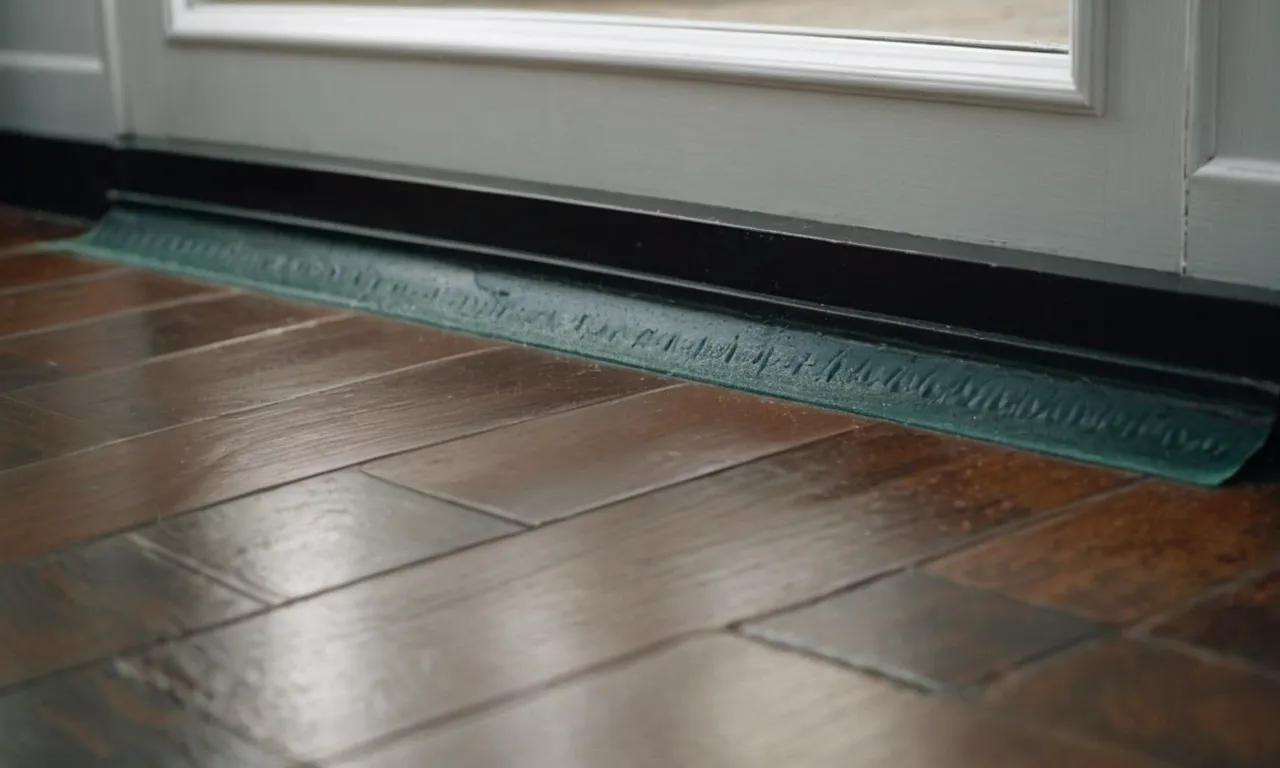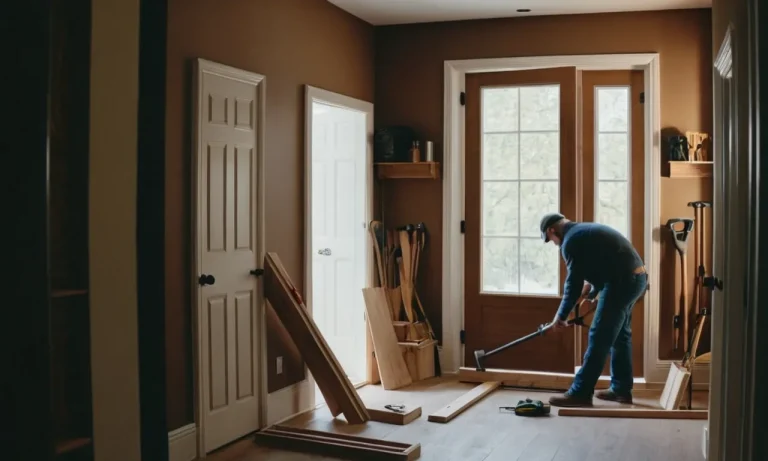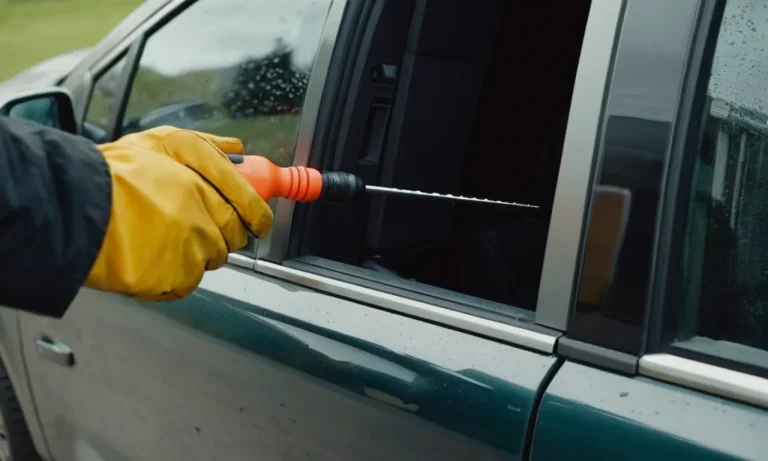How To Stop Water From Coming Under Your Door
Dealing with water leaking under interior doors can be frustrating. A growing puddle on your floor is not only annoying but can also lead to water damage and mold growth if left unchecked. Luckily, there are several effective techniques you can use to stop water from flowing into rooms it’s not supposed to.
If you’re short on time, here’s a quick answer to your question: Place a towel or rag against the bottom of the door to absorb water and block its path. For a more permanent solution, install door sweeps or replace the door’s threshold.
Identify and Address the Source of the Water
Check where the water is coming from
When faced with water coming under your door, it’s important to first identify where the water is coming from. Is it rainwater seeping in from outside, or is it a result of plumbing issues within your home? By determining the source of the water, you can take appropriate steps to address the problem.
Unclog drains or fix leaky plumbing
If the water is coming from a drain or a leaky pipe, it’s crucial to unclog the drain or fix the plumbing issue as soon as possible. Clogged drains can cause water to back up and overflow, while leaky pipes can lead to continuous water leakage.
In both cases, it’s best to seek professional help to ensure the problem is resolved effectively.
Address flooding issues outside
If the water is entering from outside, it may be due to flooding or poor drainage around your property. One way to address this is by ensuring that your gutters and downspouts are clear of debris and functioning properly.
Additionally, consider landscaping techniques such as grading the soil away from your home’s foundation to divert water flow away from your door.
Remember, addressing the source of the water is crucial in preventing further damage and keeping your home dry. If you’re unsure about the cause or unable to resolve the issue yourself, don’t hesitate to reach out to professionals who can provide expert advice and assistance.
Use Towels or Rags as a Temporary Solution
When water starts seeping in under your door, it’s important to take immediate action to prevent any further damage. One simple and effective way to stop the water flow is by using towels or rags as a temporary solution.
These household items can act as barriers, preventing the water from spreading into your home.
Steps to Follow:
- Identify the source of the water: Before placing towels or rags, it’s essential to locate the source of the water. This could be due to heavy rainfall, a leaky pipe, or flooding from outside. By addressing the root cause, you can minimize the chances of water seeping in again.
- Gather absorbent towels or rags: Look for thick, absorbent towels or rags that can soak up the water effectively. Microfiber towels or old bath towels work well for this purpose.
- Place the towels strategically: Roll up the towels tightly and place them at the bottom of the door, creating a barrier to prevent water from entering. Make sure to cover the entire width of the door to ensure maximum protection.
- Secure the towels in place: You can use tape or adhesive strips to secure the towels in place and prevent them from shifting. This will ensure that the barrier remains intact and prevents any water from seeping through the gaps.
It’s important to note that using towels or rags is a temporary solution and may not be sufficient for long-term protection. If you’re facing recurrent water leakage issues, it’s advisable to seek professional help to address the underlying problem.
For more information and tips on preventing water damage, you can visit websites like Home Depot or ServiceMaster Restore. These resources provide expert advice and guidance on protecting your home from water-related issues.
Install Draft Blockers or Door Sweeps
If you’re tired of water seeping under your door during heavy rainstorms or floods, installing draft blockers or door sweeps can be an effective solution. These handy devices create a barrier to prevent water, drafts, and even pests from entering your home through the gaps under your doors.
Here are some tips for choosing and installing the right draft blocker or door sweep:
Choose screw-on or adhesive door sweeps
When selecting a door sweep, you have the option of choosing between screw-on or adhesive types. Screw-on door sweeps are more secure and durable, as they are attached to the bottom of the door with screws.
Adhesive door sweeps, on the other hand, are easier to install and remove, making them a great choice if you’re renting or want a temporary solution. Consider the material of your door and personal preference when deciding which type to go for.
Get door sweeps with bristles or rubber flaps
Door sweeps come in various designs, including those with bristles or rubber flaps. Bristle door sweeps work well for uneven surfaces and can effectively block out water and drafts. Rubber flap door sweeps provide a tighter seal and are great for preventing water from entering your home.
Choose the type that suits your specific needs and the level of protection you desire.
Cut sweeps to fit your door’s dimensions
Once you’ve chosen the right door sweep, it’s important to ensure that it fits your door’s dimensions properly. Measure the width of your door and trim the door sweep accordingly to achieve the perfect fit.
A door sweep that is too long may scrape against the floor, while one that is too short will not provide adequate protection. Take your time to measure accurately and trim the sweep as necessary for optimal results.
Remember, installing draft blockers or door sweeps is an effective way to keep water from coming under your door. By following these tips, you can choose the right type of door sweep and ensure proper installation, providing you with peace of mind during rainy seasons or flooding events.
Weatherstrip Underneath the Door
One effective way to stop water from coming under your door is by weatherstripping the area underneath it. Weatherstripping creates a seal that prevents water, drafts, and insects from entering your home. Here are some options for weatherstripping:
Use self-adhesive foam or vinyl strips
Self-adhesive foam or vinyl strips are affordable and easy to install. Simply measure the length of the door and cut the strips accordingly. Peel off the backing and press the adhesive side onto the bottom of the door. The foam or vinyl will create a barrier that helps keep water out.
Install compression seals for a tight fit
Compression seals are a more durable option for weatherstripping. These seals consist of a rubber or silicone material that compresses when the door is closed, creating a tight seal. They are available in various sizes and can be installed using screws or adhesive.
Compression seals are highly effective at preventing water leakage.
Replace worn out door bottoms
If your door has a worn-out or damaged bottom, it may be allowing water to seep in. In such cases, replacing the door bottom is necessary. Measure the width of the door and purchase a replacement door sweep or threshold.
Remove the old door bottom and attach the new one according to the manufacturer’s instructions. This will ensure a proper seal and prevent water from entering underneath the door.
Remember, regular maintenance is crucial to keeping your door weatherproof. Check the condition of the weatherstripping and door bottoms periodically and replace them as needed. By taking these preventive measures, you can effectively stop water from coming under your door and keep your home dry and protected.
Add a New Door Sill or Threshold
If you want to stop water from coming under your door, adding a new door sill or threshold is a great solution. A door sill or threshold is a piece of material that sits at the bottom of your door, creating a barrier between the inside and outside.
It helps to keep water, drafts, and insects from entering your home.
Get sills made of vinyl, metal, or wood
When choosing a new door sill or threshold, you have several options to consider. Vinyl, metal, and wood are popular materials used for sills because they are durable and weather-resistant. Vinyl sills are great for areas with high moisture, as they won’t warp or rot.
Metal sills are sturdy and can withstand heavy foot traffic. Wood sills provide a classic look and can be painted or stained to match your decor.
Choose the right height and fit
It’s important to choose a door sill or threshold that is the right height and fit for your door. Measure the width of your door frame to ensure you select a sill that will cover the entire width. Additionally, consider the height of the sill in relation to the gap between the bottom of your door and the floor.
You want the sill to create a tight seal without obstructing the door’s opening and closing.
Seal the sill to the floor properly
Once you have installed the new door sill or threshold, it’s crucial to seal it properly to the floor. This will prevent any water from seeping underneath. Use a high-quality sealant or caulk to create a watertight seal between the sill and the floor.
Be sure to follow the manufacturer’s instructions for application and drying time. Regularly checking and maintaining the sealant will help ensure its effectiveness over time.
For more information on selecting and installing door sills or thresholds, visit www.homeadvisor.com.
Caulk Around the Door Frame
To stop water from coming under your door, one effective solution is to caulk around the door frame. Caulking creates a watertight seal that prevents water from seeping through gaps and cracks. It is a simple and cost-effective way to protect your home from water damage.
Clear away old caulk and dirt
Before applying new caulk, it is important to remove any old caulk and dirt from the door frame. Use a putty knife or a caulk removal tool to scrape away the old caulk. Make sure to clean the area thoroughly to ensure proper adhesion of the new caulk.
Apply silicone caulk evenly
Once the surface is clean and dry, it’s time to apply the new caulk. Choose a high-quality silicone caulk that is specifically designed for exterior use. Cut the tip of the caulk tube at a 45-degree angle, then load it into a caulk gun.
Apply an even bead of caulk along the edge of the door frame, making sure to fill any gaps or cracks.
Smooth the caulk with your finger
To achieve a neat and professional finish, use your finger to smooth the caulk. Wet your finger with a small amount of water or rubbing alcohol to prevent the caulk from sticking to your skin. Gently run your finger along the caulk line, smoothing it out and removing any excess caulk.
This will create a clean and seamless seal.
Remember, proper caulk application is essential for preventing water from coming under your door. Take your time and follow the instructions carefully to ensure a long-lasting and effective seal. If you are unsure or uncomfortable doing this yourself, it is always best to consult a professional.
Conclusion
Water passing under a door can quickly become a big hassle. Thankfully, there are many simple and affordable ways to tackle this issue, from quick fixes like using towels to more permanent solutions like weatherstripping and door sweeps.
Investing a small amount of time and money into stopping that stream of water from invading your space will be well worth it in the long run. With a dry floor you’ll avoid further water damage, potential mold growth, and safety hazards.







